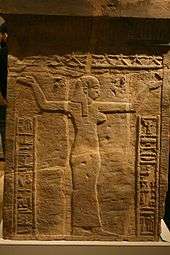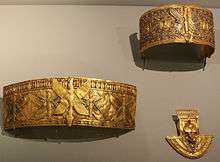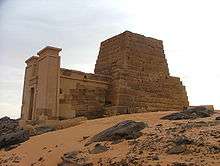Kandake

Kandake, kadake or kentake, often Latinised as Candace (Ancient Greek: Κανδάκη), was the Meroitic language term for "queen" or possibly "royal woman". Contemporary Greek and Roman sources treat it as a title. Several ruling queens of the ancient Kingdom of Kush, with its capital at Meroë, bore the title, although it may have been a general title for women of the royal family. It is often taken to mean "queen-mother" or "mother of the reigning king", but although this was the common status of ruling kandakes, the term itself did not have this specific meaning. The name Candace is derived from the way the word is used in the New Testament, (Acts 8:27).[1][2][3]
Archaeological sources
Bas-reliefs dated to about 170 B.C. reveal kentakes Shanakdakheto, dressed in armor and wielding a spear in battle. She did not rule as queen regent or queen mother, but as a fully independent ruler. Her husband was her consort. In bas-reliefs found in the ruins of building projects she commissioned, Shanakdakheto is portrayed both alone as well as with her husband and son, who would inherit the throne by her death.
Greco-Roman sources
Pliny writes that the "Queen of the Ethiopians" bore the title Candace, and indicates that the Ethiopians had conquered ancient Syria and the Mediterranean.[4]
In 25 BC the Kush kandake Amanirenas, as reported by Strabo, attacked the city of Syene, today's Aswan, in territory of the Roman Empire; Emperor Augustus destroyed the city of Napata in retaliation.[5][6]
Four African queens were known to the Greco-Roman world as the "Candaces": Amanishakhete, Amanirenas, Nawidemak, and Malegereabar.
Biblical usage
In the New Testament of the Christian Bible, a treasury official of "Candace, queen of the Ethiopians", returning from a trip to Jerusalem, met with Philip the Evangelist:
Then the Angel of the Lord said to Philip, Start out and go south to the road that leads down from Jerusalem to Gaza, which is desert. And he arose and went: And behold, a man of Ethiopia, an Eunuch of great authority under Candace, Queen of Ethiopians, who had the charge of all her treasure, and had come to Jerusalem to worship.[7]
The queen concerned may have been Amantitere (AD 22–41).
He discussed with Philip the meaning of a perplexing passage from the prophet Isaiah.[8] Philip explained the scripture to him and he was promptly baptised in some nearby water. The eunuch 'went on his way, rejoicing',[9] and presumably therefore reported back on his conversion to the Kandake.
Alexandrian legend

A legend in the Alexander romance claims that "Candace of Meroë" fought Alexander the Great.[10] In fact, Alexander never attacked Nubia and never attempted to move further south than the oasis of Siwa in Egypt.[11][12] The story is that when Alexander attempted to conquer her lands in 332 BC, she arranged her armies strategically to meet him and was present on a war elephant when he approached. Having assessed the strength of her armies, Alexander decided to withdraw from Nubia, heading to Egypt instead. Another story claims that Alexander and Candace had a romantic encounter.
These accounts originate from "The Alexander Romance" by an unknown writer called Pseudo-Callisthenes, and the work is largely a fictionalized and grandiose account of Alexander's life.[11] It is commonly quoted, but there seems to be no historical reference to this event from Alexander's time. The whole story of Alexander and Candace's encounter appears to be legendary.[12][11]
Kandakes of Kush

- Shanakdakhete (177 BCE–155 BCE) (earliest known ruling queen)
- Amanirenas (40 BCE–10 BCE)
- Amanishakheto (c. 10 BCE–1 CE)
- Amanitore (1–20 CE)
- Amantitere (22–41 CE)
- Amanikhatashan (62–85 CE)
- Maleqorobar (266–283 CE)
- Lahideamani (306–314 CE)
References
- ↑ Lobban, Richard A. Jr. (2003). Historical Dictionary of Ancient and Medieval Nubia. Lanham, MD: Scarecrow Press. ISBN 978-0-8108-6578-5.
- ↑ Miriam Ma'at-ka-re Monges (2005). "Kush". In Molefi Kete Asante, Ama Mazama. Encyclopedia of Black Studies. Sage. p. 302. ISBN 978-0-7619-2762-4.
- ↑ Fage, John. A History of Africa. Routledge. p. 115. ISBN 1317797272.
- ↑ Turner, Sharon (1834). The Sacred History of the World, as Displayed in the Creation and Subsequent Events to the Deluge: Attempted to be Philosophically Considered, in a Series of Letters to a Son,. Vol. 2. Longman. pp. 480–482.
- ↑ Fluehr-Lobban, Carolyn (August 20, 1998). "Nubian Queens in the Nile Valley and Afro-Asiatic Cultural History" (PDF). Ninth International Conference for Nubian Studies. Museum of Fine Arts, Boston U.S.A. Retrieved 2018-06-07.
- ↑ Budge, Sir Ernest Alfred Wallis (1911). Cook's handbook for Egypt and the Egyptian Sûdân. T. Cook & Son. p. 737.
- ↑ Acts 8:26-27
- ↑ Isaiah 53:7-8
- ↑ Acts 8:39
- ↑ Jones, David E. (1997). Women Warriors: A History. Brassey. p. 82. ISBN 978-1-57488-106-6.
- 1 2 3 Goldenberg, David M. (2009). The Curse of Ham: Race and Slavery in Early Judaism, Christianity, and Islam. Princeton University Press. p. 64. ISBN 1-4008-2854-6.
- 1 2 Morgan, John Robert; Morgan, J. R.; Stoneman, Richard (1994). Greek Fiction: The Greek Novel in Context. Psychology Press. pp. 117–118. ISBN 978-0-415-08507-6.